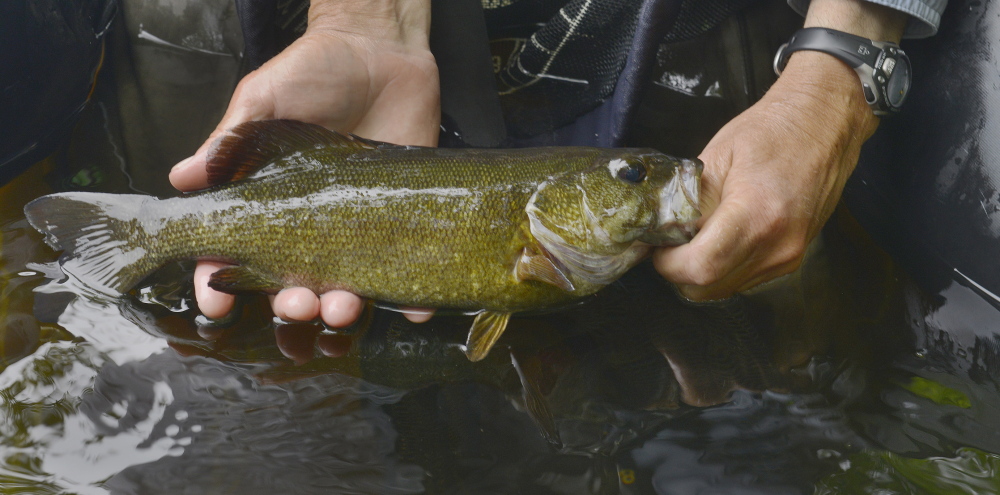Maine black bass are spawning now, so fishing for them is as good as it gets – reason enough to cast to shallow coves in lakes, ponds and rivers. When sunlight shines on bottom, astute observers can easily spot the 14- to 30-inch spawning beds, which male bass aggressively defend.
Pugnacious males think fishing lures are threatening their young and strike with reckless abandon at the offerings, so casters do well now.
Scientific anglers with water thermometers can measure temperatures to ascertain when bass initiate nest construction and spawning. Smallmouth males build nests in 55-degree water and females lay eggs when the thermometer reads 60 to 66 degrees. Largemouths initiate spawning behavior when temps exceed 60 degrees, and females deposit eggs when the water reaches 63 degrees. It’s fun to keep track of temperatures to see how accurate these numbers are each spring.
In late spring during my mid-teens, these ever-cooperative black bass helped me polish my hook-setting and fish-playing techniques with fly-fishing gear – the latter particularly true when fighting a battler on loose line. Unless I could rapidly tighten the line, the bass usually threw the hook.
A real plus in my fly-rodding education was this: Smallmouth and largemouth bass often run larger and fight harder than brook trout – great practice when fishing for this smaller trout species. In many Maine anglers’ experience, a “trophy” brookie is the size of an average bass.
So my introduction to bass came as practice for salmonids, but many folks just like bass. For them, cold-water species with adipose fins prove an unimportant consideration, and they adore the looks of a bass. You know the old saw about beauty being in the eyes of the beholder.
When I was in my early 20s and just out of college, I taught English at Jefferson Village School east of Augusta and coached a wonderful, winning baseball team. That last endeavor interfered big time with my trout fishing, so at dusk just after baseball practice or a game, I’d only have time to fish for smallmouth bass on Damariscotta Lake’s north shoreline in front of my rented cottage. The smallmouths averaged 15 inches, and 3-pounders and much bigger were common enough, a fun battle from my 18-foot canoe.
These days, I fish for smallmouths with an 8-weight fly rod and often a weighted No. 4 Wooly Bugger – a black or chartreuse pattern. These Buggers prove large enough to cast with a light spinning rod, explaining my 8-weight choice. The chartreuse choice can keep a bend in the rod in Maine, and the black one works particularly well if the body material is black herl and peacock herl twisted together. That bronze-green peacock shade probably suggests a real leech, and for sure, Buggers look like leeches.
Bucktail and streamer patterns imitating prevalent baitfish also fool smallmouths and largemouths, but I have never tested the theory enough to sell that article idea to a national magazine. It seems plausible, because imitating saltwater baitfish and crustaceans with flies sure fools striped bass.
Here’s another thing about bass. Back in the 1980s, many Mays on Long Pond produced dry-fly fishing for brookies and the occasional salmon, rising to insects. At the time, small smallmouths in the 10- to 12-inch range also rose to dry flies with delicate rise rings – just like a salmonid.
With all that said, if I had to fish for bass with Wooly Buggers the rest of my life, that would be fine.
Central Maine contains many small, undeveloped ponds with smallmouths and largemouths, ideal for a canoe or small rowboat and a fly rod or ultra-weight spinning outfit. Bass fishing in some of these ponds comes and goes because of 1) overfishing coupled with a catch-and-kill philosophy or 2) underfishing. Naturally, lack of fishing pressure results in a water being overpopulated with bass, stunting growth.
Two topnotch bass waters for me have been Turner Mill Pond (just largemouths) in Somerville and Stevens Pond in Liberty, just to name two that have offered lifelong memories.
Hutchinson Pond in Hallowell and Manchester (The Maine Atlas and Gazetteer, Map 12, C-4, a DeLorme’s publication) has long produced exciting reports from bass anglers, a bass guide and fisheries biologist – the latter who studied the pond.
Another tip for potential bass waters would begin with anglers calling 207-287-8000 at IFW and asking for the phone number of a fisheries biologist in the region where folks intend to fish. A pond with just a hand-carry boat launch often produces grand fishing, because it reduces fishing pressure when folks can’t back a trailer to the water. Many bass ponds in central Maine have just one to two or no shoreside dwellings – solitude and exciting action.
Ken Allen, of Belgrade Lakes, a writer, editor and photographer, may be reached at
KAllyn800@yahoo.com
Send questions/comments to the editors.



Success. Please wait for the page to reload. If the page does not reload within 5 seconds, please refresh the page.
Enter your email and password to access comments.
Hi, to comment on stories you must . This profile is in addition to your subscription and website login.
Already have a commenting profile? .
Invalid username/password.
Please check your email to confirm and complete your registration.
Only subscribers are eligible to post comments. Please subscribe or login first for digital access. Here’s why.
Use the form below to reset your password. When you've submitted your account email, we will send an email with a reset code.